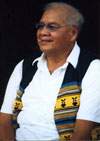
Howard Tommie
Howard Tommie. Howard, a Brighton Reservation resident, served the Seminole Tribe of Florida as the Chairman from 1971 to 1979. Howard is credited with setting the legal precedent for Tribal gaming when he started the first Tribally-owned high-stakes bingo hall on the Hollywood Reservation in 1979.
Pictured: Howard Tommie
To download the podcast, right click on the above link and "Save Target As" or "Save Link As" to your computer.
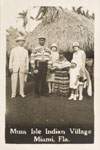
Civil Rights
We Shall Never Forget. In this clip, Moses Jumper, Jr., a Big Cypress Reservation resident, discusses his experiences with Jim Crow laws in the south and finding inspiration to become involved with the American Indian Movement (AIM). He also discusses the Democratic National Convention in Miami Beach in 1969. The next speaker, O.B. Osceola, Sr., a Naples Community resident, shares his experiences in the segregated south when he was a high school student.
To download the podcast, right click on the above link and "Save Target As" or "Save Link As" to your computer.
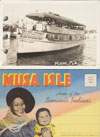
Tourist Camps
The Tourist Camps. Seminole tourist camps ranged in size from individual enterprises located along the Tamiami Trail and other locations to large tourist attractions such as Musa Isle, Tropical Hobbyland, and Coppinger's Pirate's Cove. Another tourist enterprise was the cruise ships that transported tourists between villages along the New River. In the first clip, Michael Tiger, Treasurer for the Seminole Tribe of Florida and Hollywood Reservation resident, describes singing at the docks for the Jungle Queen boat cruise. The next clip is from James Billie, Brighton Reservation resident and former Chairman of the Seminole Tribe of Florida (1979-2001). In this clip, James explains how difficult it was to make a profit in the tourist villages and how meaningful the tourism industry is to him. In the final clip, Mary Bowers, Hollywood Reservation resident, describes how the tourist camps depicted Seminole life.
Pictured: Left: Lena Osceola, Right (baby): Ethel Frank Santiago
To download the podcast, right click on the above link and "Save Target As" or "Save Link As" to your computer.
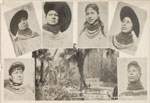
Silver Springs
Seminole Indian Village, Silver Springs, FL. Silver Springs is located in Ocala, FL. This location has been inhabited for thousands of years by Native people, including the Seminole Indians, and later by white settlers. In the 1930s, Ross Allen opened a reptile institute at the Silver Springs tourist attraction. Pedro Zepeda, Seminole Tribal member and Naples resident, reads Ross Allen's account of opening the Seminole Village at Silver Springs. Ross Allen's interview was conducted on November 11, 1970 by the University of Florida's Samuel Proctor Oral History Program. The second description comes from a former Ross Allen employee, Earl Debary. Earl describes the skills and knowledge of canoe builder Charlie Cypress. The last oral history comes from George Billie, Big Cypress Reservation resident and grandson of Charlie Cypress. In George's account, he shares the legend of Silver Springs as it was told to him by his grandmother.
Pictured: Bottom center: Silver Springs, Bottom left: Lee Cypress, Top left: Willie Mae Billie, Center left: Eddie Billie, Center Right: Alice Jimmie
To download the podcast, right click on the above link and "Save Target As" or "Save Link As" to your computer.
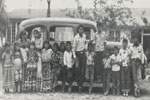
Brighton Day School
Brighton Day School. In the 1930s, the federal government hired Mr. and Mrs. William Boehmer to open a school on the Brighton Reservation. On January 9, 1939, the Brighton Day School opened its doors to Seminole children. Lorene Gopher, Brighton Reservation resident and Tribal Culture Program Director, describes attending the school and Mr. and Mrs. Boehmer's roles in the school.
Pictured: ca. 1951-52. School Children at Brighton Indian Day School. L to R. Josephine Huff Youngblood, Elaine Johnson Aguilar, Mildred Bowers (rear), Lawanna Osceola Niles, Lorene Bowers Gopher, Elsie Jean Bowers (rear), Gladys Bowers Bratcher, Richard Smith, James Frank Tiger, Billy Micco, Coleman Josh, Russell Osceola, Jerry Micco, Jim Shore, Brown Shore, Eddie Shore, Jimmie Scott Osceola
To download the podcast, right click on the above link and "Save Target As" or "Save Link As" to your computer.
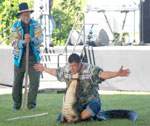
Alligator Wrestling
Alligator wrestling is a dangerous tradition of showmanship, but it is also very lucrative. During the period of the early tourist camps in the 1930s and 1940s, alligator wrestling generated considerable income. In this clip Everett Osceola, Hollywood Reservation resident, describes his experience learning how to wrestle alligators. The next speaker, Billy Walker, Big Cypress Reservation resident, explains the permissions an alligator wrestler must receive from the Snake Clan before they can touch an alligator. The final clip comes from Zack Battiest, Hollywood Reservation resident, who explains what alligator wrestling actually is.
Pictured: Billy Walker at AIAC 2008. In the background, George Billie, former alligator wrestler.
To download the podcast, right click on the above link and "Save Target As" or "Save Link As" to your computer.

Marketable Traditions
Patchwork, Beadwork, Dolls, and Baskets. The various artwork of the Seminoles helped to support their economy. On the Brighton Reservation, the Seminole women joined the Seminole Crafts Guild of Glades County in the 1930s. By 1940, Cohen Brothers department store in Jacksonville, FL, the largest in Florida at the time, was paying cash for Seminole crafts and selling them in their store. In Miami, Dania, and along the Tamiami Trail, the Seminole arts were being sold to the tourists. Mabel Osceola Moses, Hollywood Reservation resident, tells a story she heard from her mother about how her family began selling dolls to Corey Osceola for his village. In the second clip Mary Bowers, Hollywood Reservation resident, explains how her aunt taught her to make beadwork.
Pictured: Betty Osceola
To download the podcast, right click on the above link and "Save Target As" or "Save Link As" to your computer.
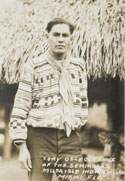
Cory Osceola
Cory Osceola was a natural leader and had an entrepreneurial spirit. He interpreted for Mikasuki speakers who could not speak English, helped Seminole people start businesses, and started his own tourist villages. O.B. Osceola, Sr., Naples Community resident and son of Cory Osceola, reminisces about his father's role in the Seminole Tribe. The last speaker, Tina Osceola, Chief Historic Resources Officer for the Seminole Tribe, Executive Director of the Ah-Tah-Thi-Ki Seminole Indian Museum and granddaughter of Cory Osceola, explains the influence her grandfather had on her.
Pictured: Cory Osceola
To download the podcast, right click on the above link and "Save Target As" or "Save Link As" to your computer.